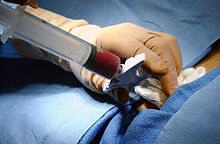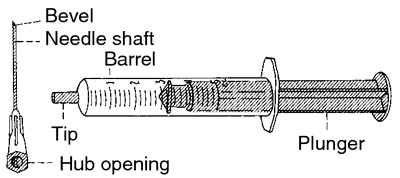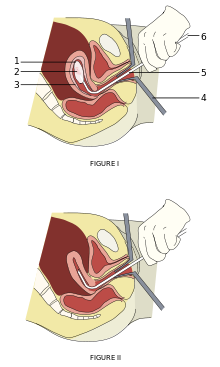

What is an Aspirating Syringe vs. a Non-Aspirating Syringe
What is an aspirating syringe?
To best understand the function of the aspirating syringe, let us first clear up what it means to aspirate, medically speaking. Aspiration is the removal of fluids or cells such as blood, pus, cerebrospinal fluid or ascites from the body. Syringes, although commonly used to inject medication into the body, now have the function to aspirate as well. In an aspirating syringe, the plunger of the syringe is pulled back either to intentionally remove fluid or cells or create a vacuum for approximately five to ten seconds prior to injecting medicine, so the healthcare provider is positive that the needle tip is located at the appropriate spot, away from blood vessels that should not be punctured. After the area is secured and the aspirator is ready. Aspirating syringes most commonly inject local anesthetics and are used in the practice of dentistry.
The apparatus is distinguishable from most other instruments with its larger thumb rings, but what exactly makes it up and how are its functions unique? A few small and simple pieces, including a thumb ring, finger grip, finger bar, barrel, where the carpule is placed, piston rod and harpoon, which embeds into the rubber stopper, and threaded tip, where the needle attaches, come together to make this device. The way this tool differs from other syringes is that it is meant to inject anesthetic from a carpule. Through aspiration, breath or air is drawn to assure that no blood vessel or artery has been hit, as to prevent the injection of fluid into the wrong spot. We will get into this more later.
Why aspirate?
One of the greatest benefits of using an aspirating syringe, as briefly illustrated above, is having the knowledge, confidence and comfort in knowing that the needle is located in the right spot inside the skin, before any further action is taken. When using needles, you must be certain not to hit a blood vessel or artery. Instead, air will be drawn, until it is clear that everything is in place, and the insertion or extraction may continue. As learned above, aspirating syringes are used in a number of scenarios, procedures, and areas on the body, sometimes to extract material and sometimes to inject. By using the tool to aspirate, extraction of biological information is possible, helpful and sometimes necessary in determining appropriate treatments for patients. This biological information, as revealed in forms such as removed cells or fluids could be used in a laboratory biopsy, for instance, to better understand what is happening in the body. Understanding the the body’s inner workings is the first step forward, and allows healthcare providers the basic information for what to do next. Pus or purulent material from dermatological problems can be sent to a bacteriological laboratory, to determine causes of infections.
According to WHO’s Global Facts & Figures via F1000Research Open for Science, “an estimated 16 billion injections per year are administered in the developing and transitional countries alone.” “Yasir Sepah and Lubna Samad, F1000 Research” This topic, although not so widely researched, is one that deserves more attention, as this one tool has a direct effect on a vast majority of patients. Because aspirating is not always necessary with every procedure, and because the topic is less widely researched than others, there has been controversy over whether or not aspiration is the way to go. However, medical experts claim that usage is simple, does not generate negative feedback from patients, and is with little to no increase in costs. If aspiration is not performed prior to injection, a plethora of side effects, including nausea, coughing, dizziness, increased heart rate, coma, or even death might occur.
Aspirating when administering heparin or insulin is not recommended because it is classified as a subcutaneous injection rather than an intramuscular injection. In this case, the chance of injecting fluid into a blood vessel is rare. Aspirating in this case would only heighten the chance of bleeding into the tissue from the rupture of blood vessels.
What about conventional syringes?
Although conventional syringes have one main purpose, i.e to inject, they have been used to aspirate fluids such as synovial fluid, amniotic fluid, cells, and more as well. However, studies have revealed that a conventional syringe is not the most appropriate tool when it comes to aspiration in terms of control and precision. If the patient or health care provider hits the wrong spot, immediate and secondary issues may arise such as the follow through of an inaccurate procedure, accidental puncture of a blood vessel or neve bundle, and later, an inaccurate diagnosis. As if being poked isn’t uncomfortable enough already!

Where, when and how?
According to dentalcare.com, “the Centers for Disease Control and Prevention (CDC) estimate that approximately 600,000 to 1,000,000 needlestick and other percutaneous injuries occurred annually among U.S healthcare workers, potentially exposing medical and dental team members to bloodborne pathogens such as human immunodeficiency virus (HIV), hepatitis B virus (HBV) and hepatitis C virus (HCV).” Precision, accuracy and care are crucial when using these tools. Some injections can be performed manually and at home. This can save time, money and a trip to the doctor, if you have the proper tools, means and purpose.
In the case that application is done at home and the resources are available, for optimal comfort, ati Nursing suggests applying “EMLA (eutectic mixture of lidocaine 2.5% and prilocaine 2.5%) cream to the injection site for 1 to 3 hours prior to the injection. Otherwise, try vapocoolant spray (an aerosolized volatile refrigerant liquid) or manual pressure just before giving the injection. atitesting.com” Use medications that are at room temperature as opposed to those that are cold. Make certain the skin is dry before injection. Use a clean needle, which should also be the smallest-gauge needle as possible. Dart the needle quickly into and out of the skin, maintaining stability during the injection, which should be a slow process. Apply gentle pressure with a dry, flexible material such as a gauze pad or cotton ball. If there is not much body fat on the subject, use the upper abdomen, for a place of fatty tissue. When injecting insulin, this is also the spot that is quickest to absorb, followed by the arms, thighs and buttocks.
During this process of aspirating, nothing should retrieve back into the syringe. This is how you will know that you are in the right spot. If blood becomes visible in the syringe, remove the needle and find a new spot. This indicates that you have hit a blood vessel or artery, and should not inject. You are not looking to strike oil! Use a new and clean tool when starting again to prevent infection. If the needle hits a bone while administering injection, withdraw the needle a fourth of an inch but do not remove it entirely and continue with the injection.
References:
BriteSources (2015, February 27). Preparation of Aspirating Syringe [Video clip]. Retrieved from https://www.youtube.com/watch?v=HFJrfb0_qcA
Sepah Y, Samad L, Altaf A et al. Aspiration in injections: should we continue or abandon the practice? [version 1; referees: 1 approved, 1 approved with reservations] F1000Research 2014, 3:157 (doi:10.12688/f1000research.1113.1)
Scarlett, Margaret I, DMD. Local Anesthesia in Today’s Dental Practice. Retrieved from http://www.dentalcare.com/en-US/dental-education/continuing-education/ce364/ce364.aspx?ModuleName=coursecontent&PartID=7&SectionID=0
Integrated Publishing. (n.d.). Cement and Insulating Base Instruments, Rubber Dam Punch. Dental Technician, Volume 2, Dentist training manual for military dentists. Retrieved from http://medical.tpub.com/14275/css/14275_107.htm
ati Nursing Education. (n.d.). Frequently Asked Questions. Retrieved from http://www.atitesting.com/ati_next_gen/skillsmodules/content/medication-administration-3/faq.html?id=undefined
American Nurses Association. (2002). American Nurses Association’s Needlestick Prevention Guide. p. 17. Retrieved November 19, 2007, from http://www.needlestick.org
Centers for Disease Control and Prevention. (2007). Guideline for isolation precautions: Preventing transmission of infectious agents in healthcare settings 2007. Retrieved November 19, 2007, from http://www.cdc.gov
Occupational Safety and Health Administration. (2007). Occupational safety and health standards: Toxic and hazardous substances: Bloodborne pathogens. Retrieved November 19, 2007, from http://www.osha.gov
Perry, A. G., & Potter, P. A. (2006). Clinical nursing skills and techniques (6th ed.). St Louis, MO: Elsevier Mosby. pp. 694-695, 697-699, 714, 716-718, 720-726, 729-730.
Smith, S. F., Duell, D. J., & Martin, B. C. (2008). Clinical nursing skills: Basic to advanced skills (7th ed.).Upper Saddle River, NJ: Pearson Education, Inc. pp 603, 609, 616-617, 620-621.




2 thoughts on “What is an Aspirating Syringe vs. a Non-Aspirating Syringe”
Comments are closed.